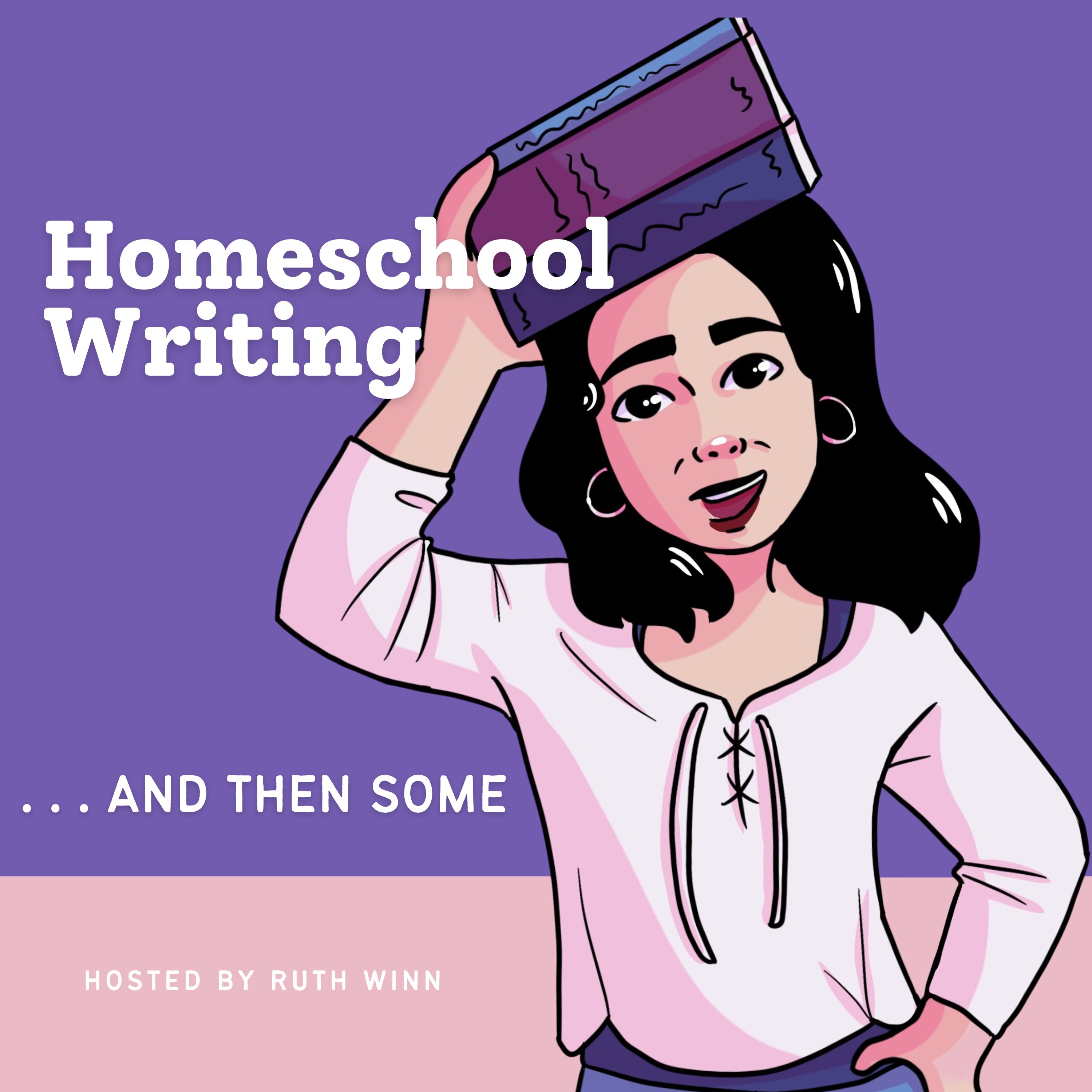
Goals
- To learn and practice the writing process
- To practice organizing and writing short, structured essays
- To become familiar with the basic modes of writing: descriptive, narrative, expository, and persuasive
This plan is ideal for …
- students who are comfortable writing paragraphs but need instruction in writing longer essays
- students who need clear instructions for writing a basic essay
- students who do not have much practice in writing but are motivated to learn the basics of formal writing
Note: Students who have limited experience with writing or who are resistant to writing might benefit more from the Basic Writing Plan.
Duration
This is a four-week plan, with one essay assignment each week.
The writing process
For each essay, students will follow these steps in the writing process:
- Prewriting—
This step is essential, so please spend plenty of time on it. Go through all the prewriting questions and prompts. One of the most frequent complaints students have is that they don’t know what to write about or they don’t have enough to say about their topic. Prewriting will largely remedy these problems. - Drafting—
In this step, students write a complete draft of their paper. Ideally, this is done in one sitting from start to finish. The key is not to worry about the mechanical aspects (grammar, spelling, punctuation, etc.), but rather to focus on getting down the main ideas in a somewhat organized fashion. - Revising—
This step is done at least a day after the rough draft is finished. It involves making large structural changes such as adding, deleting, or rearranging sentences. It can also include smaller changes, such as altering word choices or correcting sentence fragments. Especially if it is handwritten, the paper does not need to rewritten at this point. Making margin notes, drawing arrows, and crossing out words is sufficient. If at all possible, at least one other person should read the paper and give the student feedback about the content and organization of the paper. This person could be the instructor or a friend or family member. Note, however, that the focus of the feedback should be on the content, not on the mechanics. - Editing—
In this step, students prepare the final versions of their papers, incorporating their own revisions as well as the feedback they received from others. They should pay attention to mechanics—spelling, punctuation, grammar, and so on. The final step of this editing process should be to read their papers out loud—this will help them with proofreading. - Publishing—
Students should expect to share their papers with an audience. This can take many different forms. Essays might be read aloud to a co-op group or to the family after dinner. They also could be published in a homeschool newsletter or literary magazine if you have access to such a forum.
Schedule (to write a paper in one week)
Day 1: Prewriting
Day 2: Drafting
Day 3: None (take a day off between drafting and revising)
Day 4: Revising
Day 5: Proofreading/Editing; (Submit final draft for publishing)
(Repeat for each assignment)

Week 1: Description
Assignment: Describe someone who has been an important influence in your life.
Length: 300-500 words
Audience: Formal/Academic (imagine writing this essay as part of a scholarship application)
Instruction: Descriptive writing is about painting a picture for the reader. To do this, you want to use language that appeals to the five senses. The prewriting questions will guide you through this process.
Prewriting
- Make a list of people who have influenced you. Think about teachers, coaches, church leaders. Also, consider those influences that you might not know personally: singers, actors, missionaries, authors, characters in stories, politicians. Try to make a list of at least ten people.
- Circle the person on your list that you are most interested in writing about. With that person in mind, answer the following questions:
- What is the main impression you want to convey about this person? Is he/she cheerful, nervous, careful, funny, etc.?
- List three pieces of evidence that support the main impression you want to convey. For example, suppose the main impression you want to convey about your subject is that she is nervous. How do you know she is nervous? Maybe she bites her nails or jumps at the least little noise or constantly furrows her brow in a worried expression or cuts her kids’ meals into tiny bite-sized pieces to prevent choking. Think about actions and mannerisms that demonstrate the impression you want to convey.
- What sensory details can you bring in to paint a picture of this person? In other words, when you think about this person, what images come to mind?
- What does he/she look like?
- What sounds do you associate with him/her? (for example, singing or a certain accent, or the clink of pocket change)
- What smells/tastes do you associate with this person? (for example, the smell of pumpkin spice candles in Grandma’s house, or the taste of homemade apple pie, or the smell of the ocean because she lives near the beach)
- How does he/she make you feel?
- How has this person influenced you? Why is this person important to you? List the ways this person has influenced you. These are the points you will develop in your essay.

Drafting
If possible, write the essay in one sitting. Focus on ideas and organization rather than on mechanics and style.
The essay needs a minimum of three paragraphs—an introduction, body, and conclusion. However, there is no set number of paragraphs.
Introduction The goal of the introductory paragraph is to grab the reader’s attention and state the purpose of the essay.
Ways to grab the reader’s attention:
–start with an interesting detail about the person
–start with an interesting (and relevant) story about the person
Purpose:
–make a general statement (in a sentence or two) about who this person is and how he or she has influenced you.
Body: The body should describe the person and explain in detail the reason or reasons that this person is influential. For example, let’s say you are writing about the influence your grandmother has had in your life. Grandma is important because she always makes you feel loved and appreciated. She shows her love by taking the time to listen to you and by sending you special gifts. Those are the general statements that need to be described in detail. Here is an example of a paragraph that develops one of these statements.
Because Grandma believed that “idle hands were the devil’s workshop,” she was always busy, whether it was baking her famous apple turnovers or scrubbing a pile of dirty dishes. But no matter how busy she was, she always had time to listen to me. She would stop whatever she was doing, pull off her grease-stained apron, and give me a big bear hug. Then she’d invite me to sit on the settee with her and have a cookie and a cup of milk while I told her what I’d been up to lately. …
This paragraph can be further developed with additional details that reveal more of the grandmother’s character and influence. Perhaps Grandmother not only listens but also gives valuable advice, and so on. After this idea is developed, move on to the next point about Grandmother sending gifts and provide details about that idea. Continue to develop each point in this way.
Conclusion: The concluding paragraph wraps up your paper, usually by circling around to the beginning and restating the purpose in different words. An interesting detail or illustration about the person that ties in with your main idea is a good way to close.
Revising
If time permits, allow at least a day to pass before students revisit their drafts.
Students should read through their drafts and make improvements. They should also have at least one other person read their essay and make suggestions for improvement.
The draft should be considered a working copy, and as such, students should mark it up with margin notes, arrows, crossed out words, and so on.
Editing
After students are satisfied with the revisions, they should create clean copies suitable for publishing. The final step in this part of the process is for students to read their papers out loud because this will help them catch mistakes that they will miss if they only read silently
Publishing
Students should share their essays with others.
Week 2: Narration
Assignment: Write a personal narrative about an important experience in your life.
Your essay should
- be 300 to 500 words
- have a beginning, middle, and end
- be written in first person
Audience: Formal/Academic (imagine writing this essay as part of a scholarship application)
Instruction: A narrative is a story. A personal narrative, then, is a story from your life–a snapshot from your autobiography. All of us have stories that are interesting and unique to us. Your assignment is to write one of those stories. Keep in mind that this is a story not a report. A story has a beginning, middle, and end (although you don’t have to start at the beginning—often writers start in the middle and then jump back to the beginning). Notice the difference between these two examples.
Example 1: My Trip to the Zoo: Three things I liked about the zoo were the informative talks given by the zookeepers, the variety of animals, and the interactive exhibits. (A report)
Example 2: How I Almost Became a Lion’s Dinner: It seemed like an uneventful trip to the zoo until the lions’ exhibit. My sister dropped her phone over the fence, and I climbed in to retrieve it because there were no lions to be seen. Then I heard the roar; I scrambled out with the help of a zookeeper who was not very happy. (A narrative)

Can you see the difference between the two examples? The first one is a report; the second one is a story. Your narrative needs to be like the second example.
The prewriting guide will help you figure out a topic.
Prewriting
Use this list of prompts to generate ideas for a topic. Even if you think you already have a topic, go through the list anyway. One of the prompts might spur a new idea or take you in a different direction.
- A time you were surprised–
- A special trip–
- A time you got lost, or a friend/family member got lost–
- The event that made you become interested in a certain career–
- A time you got in trouble—
- A major change in your life (for example, moving to a different place)–
- A holiday/birthday that didn’t turn out like you expected–
- A fear or struggle that you overcame–
- The time your pet ran away–
- An accident–
- A time you helped out someone–
- A time when law enforcement was involved–
- A confrontation with someone–
- An adventure related to a sport/hobby–
- A time someone in your family panicked–
- Something you will always remember–
- Something strange that happened to you–
Once you have a topic, answer the following questions. This will help you organize your paper.
Conflict (What challenge/problem/difficulty needs to be resolved?)
Setting (Where/when does the story take place? This does not have to be explicitly stated in your story unless it is important to the plot.)
Characters (Who is in your story? List and briefly describe the characters [people] in your story.)
Plot (What happens? List the main events of your story.)
Resolution (How is the conflict resolved? What happens at the end?)
Drafting
If possible, write the essay in one sitting. Focus on ideas and organization rather than on mechanics and style.
Introduction: The first paragraph needs to hook the reader and introduce the conflict (problem/challenge/difficulty) that needs to be resolved.
Ways to grab the reader’s attention:
–Begin with a provocative question
–Begin with a bold or unusual statement that goes against expectations
–Make a humorous statement
–Begin with a suspenseful part of the story
These are just suggestions. Do whatever you can to make your first sentence interesting while still being relevant to your topic.
Body: In the body of the paper, tell your story. Think about what the reader needs to know for the story to make sense, but don’t weigh down the story with details that aren’t necessary. Try to paint a picture for the reader by using descriptive (sensory) language. (See the prewriting guide for Week 1 for a review of how to write descriptively.)
Conclusion: The conflict should be resolved by the end of your story. A good way to finish is to say what you learned from the event or how you were changed by what happened.
Revising
If time permits, allow at least a day to pass before students revisit their drafts.
Students should read through their drafts and make improvements. They should also have at least one other person read their essay and make suggestions for improvement.
The draft should be considered a working copy, and as such, students should mark it up with margin notes, arrows, crossed out words, and so on.
Editing
After students are satisfied with the revisions, they should create clean copies suitable for publishing. The final step in this part of the process is for students to read their papers out loud because this will help them catch mistakes that they will miss if they only read silently.
Publishing
Students should share their essays with others.

Week 3: Expository
Assignment/Audience: Write a guide to your town or city (or a nearby town or city) for someone who has never been there and has only one day to visit. This person is around the same age as you. What are the essentials to see and do? Remember this person only has ONE day to be tourist, so be selective in your recommendations.
Length: 300 to 500 words
Prewriting
- What unique attractions (restaurants, monuments, parks, natural wonders, etc.) does your city have?
- Have you been to any of these attractions? Did you enjoy them? Any fun stories to tell about them?
- Are there places/attractions in your city that a tourist might be tempted to visit but really aren’t very good based on your experience? (This might be a good to work into an introduction or conclusion.)
- What have you enjoyed doing in your city? Where do you like to go in your city?
Think about how you might introduce your guide.
- Is there anything surprising about your city?
- Do you know an unusual fact about your city?
- Do you have an interesting story to tell about one of the city’s attractions? Something that happened to you or someone else?
- Do you know or can you find a humorous fact or quote about your city?
Now choose which places you think a tourist should visit. Choose at least three places and list details about each one.
Place 1 ______
Details describing this place:
Reasons someone should visit this place:
Place 2 _______
Details describing this place:
Reasons someone should visit this place:
Place 3 ______
Details describing this place:
Reasons someone should visit this place:
Place 4 ______
Details describing this place:
Reasons someone should visit this place:
Place 5 ______
Details describing this place:
Reasons someone should visit this place:

Drafting
If possible, write the essay in one sitting. Focus on ideas and organization rather than on mechanics and style.
Introduction: The first paragraph needs to hook the reader and introduce the topic.
Ways to grab the reader’s attention
–Begin with a humorous fact or quote about your town/city
–Begin with a surprising or unusual fact about your town/city
–Begin with a story that relates to your town/city
These are just suggestions. Do whatever you can to make your first sentence interesting while still being relevant to your topic.
Body: Discuss each place you have chosen in a paragraph. Use the information that you listed at the end of the prewriting activity to develop each paragraph. The body should have at least three paragraphs.
Conclusion: The concluding paragraph wraps up your paper, usually by circling around to the beginning and restating the purpose in different words. This is also a good place to insert a warning about places to avoid in your town/city.
Revising
If time permits, allow at least a day to pass before students revisit their drafts.
Students should read through their drafts and make improvements. They should also have at least one other person read their essay and make suggestions for improvement.
The draft should be considered a working copy, and as such, students should mark it up with margin notes, arrows, crossed out words, and so on.
Editing
After students are satisfied with the revisions, they should create clean copies suitable for publishing. The final step in this part of the process is for students to read their papers out loud because this will help them catch mistakes that they will miss if they only read silently.
Publishing
Students should share their essays with others.

Week 4: Persuasive
Assignment: Write a review of a book, movie, restaurant, play, video game, concert, music album, etc., in which you make a recommendation in favor of or against it.
Audience: Formal—imagine you are writing a newspaper article for an audience that is unfamiliar with the work you are discussing
Length: 300 to 500 words
Instruction: Students should give a brief summary of the work and provide evidence that supports their recommendations. A statement such as “this work didn’t speak to me so you probably won’t like it either” is not evidence and is unlikely to convince anyone. Instead, say something like “the dialogue between the characters was stiff and unnatural—this made the characters awkward and difficult to relate to.”
Prewriting
Start by making lists of works you liked and didn’t like.
Works I especially liked:
- Books:
- Movies:
- Restaurants:
- Plays:
- Video games:
- Concerts:
- Music Albums:
- Other:
Works I especially disliked:
- Books:
- Movies:
- Restaurants:
- Plays:
- Video games:
- Concerts:
- Music Albums:
- Other:
Choose the work you want to write about
With that work in mind, use the prompts to help you develop the content of your essay
- BRIEFLY describe the work. Remember, the purpose of the essay is to make a recommendation, not to write a description. However, because your audience is unfamiliar with the work, they need to know a little bit about it. Write a couple of sentences (or bullet points to turn into sentences later) that give a general overview of the work.
- Which category does your work belong to? In other words, is it a book, movie, restaurant, etc.?
- What are the components of that category? For example, think about what makes a movie good or bad. You might consider the acting or the special effects or the story line. You could probably come up with a dozen or more elements, or components, of movies. Make a list of all the components you can think of for your category. Which components of the work do you like? Which components do you dislike? (One of these lists will probably be much longer than the other!) List the reasons you recommend/don’t recommend this work. Provide evidence for each reason. You should have at least three reasons.
Reason 1:
Evidence:
Reason 2:
Evidence:
Reason 3:
Evidence:
Reason 4:
Evidence:
Reason 5:
Evidence:
Drafting
If possible, write the essay in one sitting. Focus on ideas and organization rather than on mechanics and style.
Introduction: The first paragraph needs to hook the reader, introduce the subject, and take a position on the subject (recommend it or not recommend it).
One way to grab the reader’s attention is to make a surprise statement that goes against general opinion or approaches the subject from an unusual angle.
You may also want to include a brief summary of the work you are reviewing.
By the end of the first paragraph, it should be clear whether this will be a positive or negative review.
Body: The body of your essay should contain the evidence that supports your position. Discuss each reason in a paragraph. Use the information that you listed at the end of the prewriting activity to develop each paragraph.
Conclusion: The concluding paragraph wraps up your paper, usually by circling around to the beginning and restating the purpose in different words.
Revising
If time permits, allow at least a day to pass before students revisit their drafts.
Students should read through their drafts and make improvements. They should also have at least one other person read their essay and make suggestions for improvement.
The draft should be considered a working copy, and as such, students should mark it up with margin notes, arrows, crossed out words, and so on.
Editing
After students are satisfied with the revisions, they should create clean copies suitable for publishing. The final step in this part of the process is for students to read their papers out loud because this will help them catch mistakes that they will miss if they only read silently.
Publishing
Students should share their essays with others.

Evaluating Student Writing
Essay #1: Descriptive
Use the first assignment as a baseline to identify the student’s strengths and weaknesses. Even though the essay may be riddled with grammatical errors and punctuation mistakes, resist the urge to mark them. Focus instead on the content of the paper. Is the student able to generate, develop, and organize ideas? At this stage, content is more important than mechanics.
Quick Assessment Guide
(**Note: This is also an excellent way to help your students with revision. Apply this guide to the rough draft to see where improvements are needed, and then have students make changes for their final draft. Re-evaluate using the guide. There should be improvement!)
- Read the essay all the way through, and then use the questions to help you evaluate.
- How well does the first paragraph hook the reader with an interesting statement, story, or detail?
–It does an excellent job of engaging the reader.
–It does a sufficient job of engaging the reader.
–It needs improvement. - How well does first paragraph state the purpose (that is, who the person is and why that person is important)?
–The purpose is clearly stated.
–The purpose is somewhat suggested.
–The purpose is missing or unclear. - Does the body of the paper clearly identify the reasons for the person’s influence? (You should be able to state the reasons.)
–All the reasons are clearly identified.
–Some or all of the reasons are unclear.
–Reasons are not given. - How well do the details support/explain each reason?
–Each reason is supported by an adequate number of relevant details.
–Some reasons need more details.
–Some reasons have too many details, or details that are not relevant. - How would you describe the organization of the essay?
–It is easy to follow.
–It is confusing at times.
–It is difficult to follow. - How well does the last paragraph restate the main idea in a different way?
–It does an excellent job of wrapping up the main idea in a fresh way.
–It wraps up the main idea in words almost identical to the introduction.
–It does not wrap up the main idea. - How well is descriptive language used in the essay? (You may wish to underline some of the descriptive phrases that you liked.)
–Strong, descriptive phrases appear throughout the essay.
–Descriptive language is used several times in the essay.
–Very little descriptive language is used in the essay. - List one or two problems with mechanics (spelling, grammar, punctuation) that you noticed.
- Optional: Make a general comment about what you liked and didn’t like about the essay.

Essay #2: Narrative
Using the first essay as the baseline, look for areas of improvement in the current essay. Also note areas where the student continues to struggle. Even though the essay may be riddled with grammatical errors and punctuation mistakes, resist the urge to mark them. Focus instead on the content of the paper. Is the student able to generate, develop, and organize ideas? At this stage, content is more important than mechanics.
Quick Assessment Guide
(**Note: This is also an excellent way to help your students with revision. Apply this guide to the rough draft to see where improvements are needed, and then have students make changes for their final draft. Re-evaluate using the guide. There should be improvement!)
- Read the essay all the way through, and then answer the questions below.
- How well does the first paragraph hook the reader with an interesting statement, story, or detail?
–It does an excellent job of engaging the reader.
–It does a sufficient job of engaging the reader.
–It needs improvement. - How well does the first paragraph identify the conflict/problem/challenge/difficulty?
–The conflict is clearly identified.
–The conflict is implied but not clearly stated.
–No conflict is identified. - Does the story have a beginning, middle, and end? (Note that parts do not have to necessarily be in a linear order. Students may start in the middle or at the end of the story and then loop back around to the beginning. The point is that it must be a story not a report.)
–The story has a clear beginning, middle, and end.
–Some of the parts of the story are unclear or missing.
–The essay does not contain a storyline. - Do the details support the main point of the story?
–All the details are relevant.
–Some of the details are unnecessary.
–Not enough details are provided. - How would you describe the organization of the essay?
–It is easy to follow.
–It is confusing at times.
–It is difficult to follow. - How well is the conflict resolved? (This does not necessarily mean that the problem has gone away, but a definite conclusion needs to be reached.)
–The conflict is clearly resolved.
–The conflict is partially resolved—there are still loose ends.
–The conflict is left unresolved. - How well is descriptive language used in the essay? (You may wish to underline some of the descriptive phrases that you liked.)
–Strong, descriptive phrases appear throughout the essay.
–Descriptive language is used several times in the essay.
–Very little descriptive language is used in the essay. - List one or two problems with mechanics (spelling, grammar, punctuation) that you noticed.
- Optional: Make a general comment about what you liked and didn’t like about the essay.

Essay #3: Expository
Continue to look for areas of improvement in the current essay. Also note areas where the student continues to struggle. Even though the essay may be riddled with grammatical errors and punctuation mistakes, resist the urge to mark them. Focus instead on the content of the paper. Is the student able to generate, develop, and organize ideas? At this stage, content is more important than mechanics.
Quick Assessment Guide
(**Note: This is also an excellent way to help your students with revision. Apply this guide to the rough draft to see where improvements are needed, and then have students make changes for their final draft. Re-evaluate using the guide. There should be improvement!)
- Read the essay all the way through, and then use the questions to help you evaluate.
- How well does the first paragraph hook the reader with an interesting statement, story, or detail?
–It does an excellent job of engaging the reader.
–It does a sufficient job of engaging the reader.
–It needs improvement. - How well does first paragraph introduce the topic of the essay?
–The topic is clearly stated.
–The topic is somewhat suggested.
–The topic is missing or unclear. - Does the body of the essay clearly identify at least three places/activities? (You should be able to state them.)
–All the places/activities are clearly identified.
–Some places/activities are missing or unclear.
–There are too many or too few places/activities identified. - How well do the details support/explain each place/activity?
–Each place/activity is supported by an adequate number of relevant details.
–Some places/activities need more details.
–Some places/activities have too many details, or details that are not relevant. - How would you describe the organization of the essay?
–It is easy to follow.
–It is confusing at times.
–It is difficult to follow. - How well does the last paragraph restate the main idea in a different way?
–It does an excellent job of wrapping up the main idea in a fresh way.
–It wraps up the main idea in words almost identical to the introduction.
–It does not wrap up the main idea. - How well is descriptive language used in the essay? (You may wish to underline some of the descriptive phrases that you liked.)
–Strong, descriptive phrases appear throughout the essay.
–Descriptive language is used several times in the essay.
–Very little descriptive language is used in the essay. - List one or two problems with mechanics (spelling, grammar, punctuation) that you noticed.
- Optional: Make a general comment about what you liked and didn’t like about the essay.

Essay #4: Persuasive
Continue to look for areas of improvement in the current essay. Also note areas where the student continues to struggle. Even though the essay may be riddled with grammatical errors and punctuation mistakes, resist the urge to mark them. Focus instead on the content of the paper. Is the student able to generate, develop, and organize ideas? At this stage, content is more important than mechanics.
Quick Assessment Guide
(**Note: This is also an excellent way to help your students with revision. Apply this guide to the rough draft to see where improvements are needed, and then have students make changes for their final draft. Re-evaluate using the guide. There should be improvement!)
- Read the essay all the way through, and then use the questions to help you evaluate. Some questions may have more than one answer.
- How well does the first paragraph hook the reader with an interesting statement, story, or detail?
–It does an excellent job of engaging the reader.
–It does a sufficient job of engaging the reader.
–It needs improvement. - How well does first paragraph introduce the topic of the essay and make a recommendation about it?
–The topic and the recommendation are clear.
–The topic is unclear or missing.
–The recommendation is unclear or missing. - How well does the essay give a summary or brief overview of the work being reviewed?
–The summary or overview is clear and concise.
–The summary or overview is too long and detailed.
–The summary or overview is unclear or missing. - Does the body of the paper clearly identify at least three reasons for the recommendation? (You should be able to state them.)
–All the reasons are clearly identified.
–Some of the reasons are missing or unclear.
–No reasons are given. - How well does the evidence support each reason?
–Strong evidence is given for each reason.
–Evidence is present but weak for one or more of the reasons.
–Evidence is not given for one or more of the reasons. - How would you describe the organization of the essay?
–It is easy to follow.
–It is confusing at times.
–It is difficult to follow. - How well does the last paragraph restate the main idea in a different way?
–It does an excellent job of wrapping up the main idea in a fresh way.
–It wraps up the main idea in words almost identical to the introduction.
–It does not wrap up the main idea. - List one or two problems with mechanics (spelling, grammar, punctuation) that you noticed.
- Optional: Make a general comment about what you liked and didn’t like about the essay.
